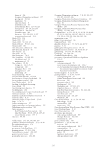7 – Connecting the champions of the Lake Eyre Basin rivers 87 Aboriginal Forum. The Scientific Advisory Panel (Fig. 7.2b) provides scientific expertise on ecology, hydrology and socio-economics. Member scientists are often actively doing research in the Basin. The natural resource management bodies are also closely connected to this process, with several members on the Community Advisory Committee (Fig. 7.2a,b). Critically, the agreement requires governments to meet regularly through a Ministerial Forum, involving relevant ministers from the Australian, Northern Territory, Queensland and South Australian governments (Fig. 7.2b). These forums provide the opportunity for candid interactions between governments, as well as a mechanism for leaders of the Community Advisory Committee and Scientific Advisory Panel to raise key issues. Biennial conferences are another requirement of the agreement, convened in different locations around the Basin until the most recent in Port Augusta in 2013 (Table 7.1, Fig. 7.6). These events brought together the general community, Traditional Owners, industry, scientists, government policy-makers, and managers to share current state of knowledge of the Basin, and nurture cross-sector and cross-border collaboration. As well, Lake Eyre Basin Aboriginal Forums, last held in 2011 (Table 7.1), were a pathway for Aboriginal people to provide strong input into the management of the Basin (see Chapter 8). The agreement also made a commitment to science, through the Lake Eyre Basin Rivers Assessment and reporting on the state of the Lake Eyre Basin every 10 years (Table 7.1). This was in addition to the independent science carried out by researchers. The Rivers Assessment involved surveying biophysical processes and functions of the Lake Eyre Basin rivers, as well as identifying potential threats (e.g. invasive species). The first State of the Basin Report was for 2008 (Lake Eyre Basin Scientific Panel 2009), with the next assessment due in 2018. These reports and independent scientific research continue to generally support assessments that the Lake Eyre Basin and its rivers remain in excellent ecological condition. However, extinction of small to medium endemic mammals is widespread in the Lake Eyre Basin (Chapter 6). Also, exotic invasive species remain an ever present and serious problem (see Chapters 1 and 3). Fig. 7.6. Landholders, Traditional Owners, scientists, government officers and industry members at the 2013 Lake Eyre Basin Biennial Conference in Port Augusta (photo, M. Turner).
Downloaded from CSIRO with access from at 216.73.216.88 on Nov 13, 2025, 1:37 PM. (c) CSIRO Publishing

















































































































































































































































































